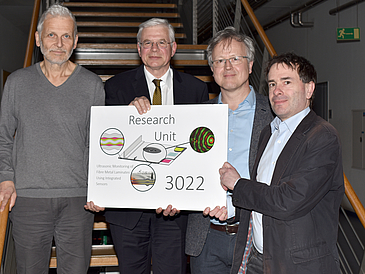Adapted from Press Release: Nr.: 60
Using built-in sensors to automatically characterize damage using ultrasonic waves and artificial intelligence - that is the goal of the new DFG research group FOR3022 with the participation of the Leibniz Institute for Materials Oriented Technologies - IWT and the University of Bremen.
Hybrid materials are increasingly being used in the aerospace industry. This is because the composites offer special functional properties that cover the increasing technical and economic requirements of these industries. Composite materials made of fiber-reinforced plastics with metal foils - so-called fiber-metal laminates - have significant advantages over aluminum, which remains the standard material in the aerospace industry, due to their hybrid structure. For this reason, fiber-metal laminates are increasingly being installed on aircraft parts that are particularly susceptible to impacts such as bird strikes. This can cause damage such as the detachment of bondings, so-called delaminations, as well as cracks that are not visible from the outside.
Long preparation time for the new project
In order to better understand and reliably diagnose damage occurring in such hybrid materials, a newly established DFG research group FOR3022 "Ultrasonic Monitoring of Fibre Metal Laminates Using Integrated Sensors" has recently dedicated itself to the investigation, characterization and diagnosis of damage in fiber-metal laminates. The research project that has now been realized was preceded by a long preparatory phase. The initial ideas for the large-scale project were developed within the framework of the former central scientific institution "Integrated Solutions in Sensorial Structure Engineering - ISIS" at the University of Bremen.
In the first phase, the research group will devote itself to this project for three years. The research group is funded by the German Research Foundation (DFG) with a funding volume of 2.7 million euros. In addition to Leibniz-IWT, the University of Bremen with its Department of Computer Science (PD Dr. Stefan Bosse) and Electrical Engineering (Professor Walter Lang) as well as the Fiber Institute (Professor Axel Herrmann), the German Aerospace Center (DLR) and Helmut Schmidt University Hamburg (HSU) are involved in the research project. Professor Michael Sinapius from the Institute of Adaptronics and Function Integration at TU Braunschweig is coordinating the project.
Every damage leaves its fingerprint
"With the new research group, we want to gain new insights into the interactions of impact damage and ultrasonic waves in fiber-metal laminates," said Axel von Hehl, head of the Lightweight Materials Department at Leibniz-IWT and a member of the MAPEX Center for Materials and Processes at the University of Bremen. "The goal of the first phase is, in particular, damage characterization. That is, we want to capture and identify the fingerprint of a specific damage." Such damage alters the propagation of ultrasound waves, which will be used for damage detection. In contrast to medical or diagnostic technology, so-called guided ultrasound waves are used. These propagate in thin-walled components such as aircraft fuselage skins. In order to know exactly which damage classes are involved in each individual case, the scientists use the high-resolution X-ray microscope available at the MAPEX Center. Based on an assignment of the damage classes to the measured ultrasonic signals, the ultrasonic testing procedure is trained until it enables reliable damage identification.
A diagnostic system for impact damage
To enable damage monitoring during operation at a later stage, the scientists are also working on integrating sensors into the material. These are to detect and characterize so-called impact damage during operation and thus provide information about the extent of damage. "In the process, the information must be obtained and derived from a large amount of raw data, which can now only be realized through automated processes and by using the methods of artificial intelligence," as private lecturer Stefan Bosse from the computer science department explains.
In a possible second three-year funding phase of the research group, the knowledge gained from damage characterization up to that point is to be incorporated into studies of damage development. This would allow more precise statements to be made about the extent of damage and the resulting need for action. On this basis, the installed sensors are to be used in the long term as a reliable diagnostic system for impact damage to aircraft.
Contact:
Carolin Haller M.A.
Leiterin Wissenschaftskommunikation
Leibniz-Institut für Werkstofforientierte Technologien - IWT
Telefon (+49) 421 218-51374
E-Mail: hallerprotect me ?!iwt-bremenprotect me ?!.de
Carolin Haller


